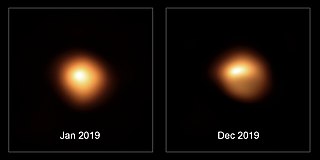
A variable star is a star whose brightness as seen from Earth changes with time. This variation may be caused by a change in emitted light or by something partly blocking the light, so variable stars are classified as either:

Leo Minor is a small and faint constellation in the northern celestial hemisphere. Its name is Latin for "the smaller lion", in contrast to Leo, the larger lion. It lies between the larger and more recognizable Ursa Major to the north and Leo to the south. Leo Minor was not regarded as a separate constellation by classical astronomers; it was designated by Johannes Hevelius in 1687.
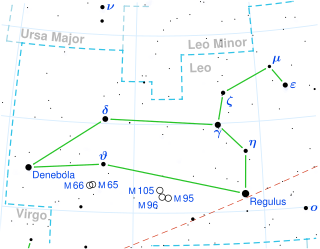
Gamma Leonis, also named Algieba, is a binary star system in the constellation of Leo, made up of two red giants. In 2009, a planetary companion around the primary was announced.
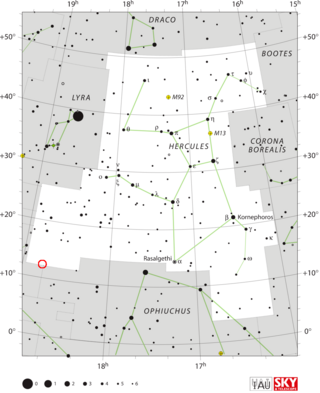
V838 Herculis, also known as Nova Herculis 1991, was a nova which occurred in the constellation Hercules in 1991. It was discovered by George Alcock of Yaxley, Cambridgeshire, England at 4:35 UT on the morning of 25 March 1991. He found it with 10×50 binoculars, and on that morning its apparent visual magnitude was 5. Palomar Sky Survey plates showed that before the outburst, the star was at photographic magnitude 20.6 and 18.25.

Delta Velorum is a triple star system in the southern constellation of Vela, near the border with Carina, and is part of the False Cross. Based on parallax measurements, it is approximately 80.6 light-years from the Sun. It is one of the stars that at times lies near the south celestial pole due to precession.

VV Cephei, also known as HD 208816, is an eclipsing binary star system located in the constellation Cepheus. It is both a B[e] star and shell star.
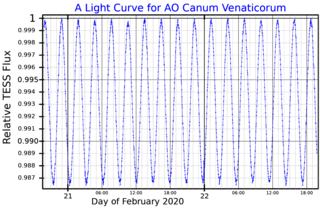
20 Canum Venaticorum is a single variable star in the northern constellation of Canes Venatici, located 238 light years from the Sun. This object has the variable star designation AO Canum Venaticorum; 20 Canum Venaticorum is the Flamsteed designation. It is visible to the naked eye as a faint, white-hued star with a baseline apparent visual magnitude of +4.72. The star is moving further from the Earth with a heliocentric radial velocity of +9 km/s. Eggen (1971) listed this star as a member of the Hyades Stream.
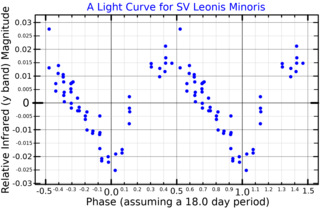
11 Leonis Minoris is a binary star located 36.5 light years away from Earth, in the northern constellation of Leo Minor. It is visible to the naked eye as a dim, yellow-hued star with an apparent visual magnitude of 5.54. The system is moving away from the Earth with a heliocentric radial velocity of +14.4 km/s. It has a relatively high proper motion, traversing the celestial sphere at the rate of 0.764 arc seconds per annum.
An AM Canum Venaticorum star, is a rare type of cataclysmic variable star named after their type star, AM Canum Venaticorum. In these hot blue binary variables, a white dwarf accretes hydrogen-poor matter from a compact companion star.
AM Canum Venaticorum is a hydrogen-deficient cataclysmic variable binary star in the constellation of Canes Venatici. It is the type star of its class of variables, the AM Canum Venaticorum stars. The system consists of a white dwarf gaining matter via an accretion disk from a semi-degenerate or white dwarf companion.

YZ Cassiopeiae is a star system 103.8 parsecs (339 ly) away from Earth, in the constellation Cassiopeia. It comprises three stars: an eclipsing Algol-type binary and a visually fainter star about 3000 AU distant.
SN 2002bj was the explosion of a star in the galaxy NGC 1821, located in the constellation Lepus. The explosion was discovered by Jack Newton in scans of images produced by Tim Puckett. Initially it had an apparent magnitude of about 14.7 and was categorized as a Type IIn supernova. However, in 2008 Dovi Poznanski discovered that the spectrum more closely resembled a Type Ia supernova. Further, the energy output was much lower than a typical supernova and the luminosity dropped at a dramatic pace.

33 Piscium is a binary star system in the zodiac constellation of Pisces. It is visible to the naked eye with an apparent visual magnitude of 4.61. The distance to this system, as determined from an annual parallax shift of 25.32±0.53 mas, is about 129 light years. It is moving closer to the Sun with a heliocentric radial velocity of −6.6 km/s.

BV Centauri is a cataclysmic variable binary star in the constellation Centaurus. It is a dwarf nova, and undergoes rapid increases in brightness that are recurrent with a mean period of 150 days. This period seems to have increased in the last few decades. During quiescence, its visual apparent magnitude is about 13, with variations of a few tenths of magnitude over an orbit due to differences in the star's visible surface area, brightening to a maximum magnitude of 10.7 during outbursts. From its luminosity, it is estimated that the system is about 500 parsecs (1,600 ly) away from Earth. A Gaia parallax of 2.81 mas has been measured, corresponding to about 360 pc.

GCIRS 16SW, also known as S97, is a contact binary star located in the Galactic Center. It is composed of two hot massive stars of equal size that orbit each other with a period of 19.5 days. The stars are so close that their atmospheres overlap, and the two stars form an eclipsing binary varying in brightness by 0.35 magnitudes at infrared wavelengths.

RS Canum Venaticorum is a binary star system in the northern constellation of Canes Venatici. It serves as the prototype to the class of RS Canum Venaticorum variables. The peak apparent visual magnitude of this system is below the level needed to observe it with the naked eye. It is located at a distance of approximately 443 light years from the Sun based on parallax, but is drifting closer with a net radial velocity of −14 km/s. Olin J. Eggen (1991) included this system as a member of the IC 2391 supercluster, but it was later excluded.

RZ Leonis Minoris is a cataclysmic variable star system in the northern constellation of Leo Minor. It undergoes frequent outbursts that vary in brightness from an apparent visual magnitude of 14.4 down to 16.8. Based on parallax measurements, this system is located at a distance of approximately 2,160 light years from the Sun.

19 Leonis Minoris is a spectroscopic binary located in the northern constellation Leo Minor. It has an apparent magnitude of 5.1, making it one of the brighter members of the constellation. The system is relatively close at a distance of 94 light years but is drifitng closer with a heliocentric radial velocity of 8.6 km/s.

OY Arae, also known as Nova Arae 1910, is a nova in the constellation Ara. It was discovered by Williamina Fleming on a Harvard Observatory photographic plate taken on April 4, 1910. At that time it had a magnitude of 6.0, making it faintly visible to the naked eye under ideal observing conditions. Examination of earlier plates showed that before the outburst it was a magnitude 17.5 object, and by March 19, 1910, it had reached magnitude 12.

35 Leonis is a spectroscopic binary star system located in the constellation of Leo, next to the star Zeta Leonis. It is made up of a yellow subgiant star and a red dwarf star, which complete an orbit between each other every 537 days. With an apparent magnitude of 5.97, the system can be naked-eye visible only from dark skies. The distance to 35 Leonis, based from data from Gaia DR3, is 31.83 parsecs (103.8 ly).

















